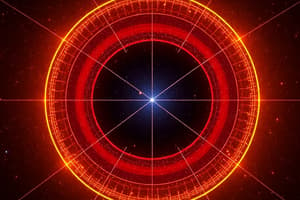Podcast
Questions and Answers
What is the total distance the UniKL Miat student walked on the first and second day if they walked 12 km east and 5 km east?
What is the total distance the UniKL Miat student walked on the first and second day if they walked 12 km east and 5 km east?
- 5 km
- 12 km
- 7 km
- 17 km (correct)
If the UniKL Miat student walked 12 km east on the first day and 5 km west on the second day, what is the magnitude of the resultant vector for the journey?
If the UniKL Miat student walked 12 km east on the first day and 5 km west on the second day, what is the magnitude of the resultant vector for the journey?
- 17 km to the east
- 7 km to the east (correct)
- 5 km to the west
- 12 km to the east
What defines an equilibrant force in a system of forces?
What defines an equilibrant force in a system of forces?
- It has a greater magnitude than the resultant.
- It acts in the same direction as the resultant force.
- It can change the direction of the resultant force.
- It is equal in magnitude and opposite in direction to the resultant. (correct)
When resolving a vector in two dimensions, what is the direction of the two component vectors?
When resolving a vector in two dimensions, what is the direction of the two component vectors?
In the context of force equilibrium, what can be said about the magnitude of the equilibrant and the resultant forces?
In the context of force equilibrium, what can be said about the magnitude of the equilibrant and the resultant forces?
What is the expression for the x-component of vector A?
What is the expression for the x-component of vector A?
Which expression correctly calculates the magnitude of vector A?
Which expression correctly calculates the magnitude of vector A?
What does tan θ represent in terms of vector components?
What does tan θ represent in terms of vector components?
If vector A has a magnitude of 150 N and an angle of 20°, what is the expression for its y-component Ay?
If vector A has a magnitude of 150 N and an angle of 20°, what is the expression for its y-component Ay?
Which of the following represents a negative component of vector B along the x-axis?
Which of the following represents a negative component of vector B along the x-axis?
When finding the resultant force of two vectors, which components are combined?
When finding the resultant force of two vectors, which components are combined?
For a vector A with a magnitude of 60 N and an angle of 35°, how can the x-component be expressed?
For a vector A with a magnitude of 60 N and an angle of 35°, how can the x-component be expressed?
Which of the following angles would need to be used for calculating the y-component of vector A at a magnitude of 150 N and an angle of 25°?
Which of the following angles would need to be used for calculating the y-component of vector A at a magnitude of 150 N and an angle of 25°?
What happens to a body when force is applied at the center of gravity?
What happens to a body when force is applied at the center of gravity?
What is produced when force is applied off the center of gravity?
What is produced when force is applied off the center of gravity?
What is essential for an aircraft’s safety in flight regarding the center of gravity?
What is essential for an aircraft’s safety in flight regarding the center of gravity?
What are the specified limits for the center of gravity of an aircraft?
What are the specified limits for the center of gravity of an aircraft?
Why is it important to evenly load an aircraft?
Why is it important to evenly load an aircraft?
What can affect the center of gravity in flight?
What can affect the center of gravity in flight?
What will happen if the center of gravity limits are exceeded?
What will happen if the center of gravity limits are exceeded?
What factors contribute to determining the center of gravity of an aircraft?
What factors contribute to determining the center of gravity of an aircraft?
What defines a ‘COUPLE’ in terms of forces?
What defines a ‘COUPLE’ in terms of forces?
What is the resultant moment of a couple also known as?
What is the resultant moment of a couple also known as?
What is the function of the centre of gravity (C of G) in flying objects?
What is the function of the centre of gravity (C of G) in flying objects?
How does the centre of gravity affect the stability of an object?
How does the centre of gravity affect the stability of an object?
What can be deduced about an object with a wide base regarding its C of G?
What can be deduced about an object with a wide base regarding its C of G?
In which scenario would an object be least stable?
In which scenario would an object be least stable?
What is a characteristic of gravity as a force?
What is a characteristic of gravity as a force?
Where does the total weight of a body appear to be concentrated?
Where does the total weight of a body appear to be concentrated?
What effect does adding detergent to water have on surface tension?
What effect does adding detergent to water have on surface tension?
What is the term for vaporization that occurs at the surface of a liquid at any temperature?
What is the term for vaporization that occurs at the surface of a liquid at any temperature?
How does surface tension behave in a liquid?
How does surface tension behave in a liquid?
What phenomenon occurs due to microscopic bubbles in a liquid?
What phenomenon occurs due to microscopic bubbles in a liquid?
What happens when the molecules in a liquid reach the boiling point?
What happens when the molecules in a liquid reach the boiling point?
What defines tensile stress in mechanical bodies?
What defines tensile stress in mechanical bodies?
Which example best illustrates compression in materials?
Which example best illustrates compression in materials?
What is the general term for the phase change from liquid to gas?
What is the general term for the phase change from liquid to gas?
What is torsion in the context of mechanical stress?
What is torsion in the context of mechanical stress?
What primarily causes the surface tension of a liquid?
What primarily causes the surface tension of a liquid?
How does bending affect an aircraft's wing during flight?
How does bending affect an aircraft's wing during flight?
What occurs to surface tension in a liquid when it is contaminated?
What occurs to surface tension in a liquid when it is contaminated?
What characterizes shear stress in materials?
What characterizes shear stress in materials?
In which scenario would torsion typically occur?
In which scenario would torsion typically occur?
Which of the following is NOT a type of stress in mechanical bodies?
Which of the following is NOT a type of stress in mechanical bodies?
What is the main purpose of a flexible steel cable in aircraft control systems?
What is the main purpose of a flexible steel cable in aircraft control systems?
Flashcards
Resultant Vector
Resultant Vector
The single vector that represents the combined effect of multiple vectors acting on an object.
Equilibrant Force
Equilibrant Force
A single force that creates balance when combined with other forces, resulting in zero net force.
Vector Component
Vector Component
A vector that forms part of the total vector; often acting along a specific axis or direction.
2-Dimensional Vectors
2-Dimensional Vectors
Signup and view all the flashcards
Mutually Perpendicular Directions
Mutually Perpendicular Directions
Signup and view all the flashcards
x-component (Ax)
x-component (Ax)
Signup and view all the flashcards
y-component (Ay)
y-component (Ay)
Signup and view all the flashcards
Vector Magnitude
Vector Magnitude
Signup and view all the flashcards
Finding Magnitude
Finding Magnitude
Signup and view all the flashcards
Direction of a Vector
Direction of a Vector
Signup and view all the flashcards
Resultant Force
Resultant Force
Signup and view all the flashcards
Vector Addition
Vector Addition
Signup and view all the flashcards
What is a 'couple' in mechanics?
What is a 'couple' in mechanics?
Signup and view all the flashcards
Torque
Torque
Signup and view all the flashcards
Gravity
Gravity
Signup and view all the flashcards
Center of Gravity
Center of Gravity
Signup and view all the flashcards
Stability
Stability
Signup and view all the flashcards
How does a lower center of gravity affect stability?
How does a lower center of gravity affect stability?
Signup and view all the flashcards
How does a wider base affect stability?
How does a wider base affect stability?
Signup and view all the flashcards
How does the position of the center of gravity affect an object's stability?
How does the position of the center of gravity affect an object's stability?
Signup and view all the flashcards
Center of Gravity (CG)
Center of Gravity (CG)
Signup and view all the flashcards
How does force affect an aircraft's CG?
How does force affect an aircraft's CG?
Signup and view all the flashcards
Why is aircraft CG important?
Why is aircraft CG important?
Signup and view all the flashcards
CG range limits
CG range limits
Signup and view all the flashcards
How does loading affect aircraft CG?
How does loading affect aircraft CG?
Signup and view all the flashcards
What can cause changes in CG during flight?
What can cause changes in CG during flight?
Signup and view all the flashcards
What happens if the CG range is exceeded?
What happens if the CG range is exceeded?
Signup and view all the flashcards
Surface Tension
Surface Tension
Signup and view all the flashcards
Contamination and Surface Tension
Contamination and Surface Tension
Signup and view all the flashcards
Evaporation
Evaporation
Signup and view all the flashcards
Boiling Point
Boiling Point
Signup and view all the flashcards
Phase Change
Phase Change
Signup and view all the flashcards
Vaporization
Vaporization
Signup and view all the flashcards
Cohesive Forces
Cohesive Forces
Signup and view all the flashcards
Microscopic Bubbles
Microscopic Bubbles
Signup and view all the flashcards
Elastic Properties
Elastic Properties
Signup and view all the flashcards
Tension
Tension
Signup and view all the flashcards
Compression
Compression
Signup and view all the flashcards
Torsion
Torsion
Signup and view all the flashcards
Bending
Bending
Signup and view all the flashcards
Shear
Shear
Signup and view all the flashcards
Clevis Bolt
Clevis Bolt
Signup and view all the flashcards
Fork & Eye
Fork & Eye
Signup and view all the flashcards
Study Notes
Statics
- Statics is the study of bodies at rest when forces are balanced.
- A force applied to a body causes that body to move in the direction of the applied force. Forces have magnitude (size) and direction.
- Some forces require contact between objects (e.g., friction between car tires and the road).
- Other forces do not require contact (e.g., force between magnets).
- Forces are vector quantities, meaning they have both magnitude and direction.
- Work is calculated as force multiplied by the distance the object moves.
- One Newton (N) is the force that gives a 1 kg mass an acceleration (or deceleration) of 1 m/s².
Learning Outcomes
- Describe statics.
- Understand forces, moments, and couples and their representation as vectors.
- Define and understand center of gravity.
- Grasp the core theory elements.
- Explain nature of properties.
- Describe pressure & buoyancy in liquids (barometer).
Scalar and Vector Quantities (Cont.)
- Scalar quantities are described by a single number (e.g., length, time, temperature, mass, density, volume).
- Vector quantities have a number and direction (e.g., force, momentum, velocity, displacement, acceleration).
- The magnitude of a vector is its size. The symbol for a vector quantity is often represented as F.
Vector Addition
- The final result of a series of displacements is the same as if the particle had undergone a single displacement, called the resultant vector or vector sum.
Forces
- A force is anything that tends to cause, stop, or change motion.
- Force is measured in Newtons (N).
Vectors in 2 Dimensions
- A vector in two dimensions can be resolved into two component vectors acting along perpendicular directions (x and y axis).
- The magnitude of a two-dimensional vector is calculated using the equation |A| = √(Ax² + Ay²). The direction of a two-dimensional vector is calculated using the equation tan θ = Ay / Ax.
Component Vectors
- Component vectors along x and y axes depend on angle θ. Signs (positive or negative) of components indicate direction relative to the axes.
Example Calculations
- Examples are provided to illustrate calculating resultant force of given vectors and solving for unknown forces.
Moments and Couples (Cont.)
- A force can cause rotation, the turning effect is the moment of a force.
- Moment depends on force magnitude and perpendicular distance (lever arm) from the force to the axis of rotation.
- Moment (Nm) equals force magnitude (N) multiplied by perpendicular distance (d).
- A force acting through the pivot does not produce rotation.
Moments and Equilibrium
- Equilibrium occurs when all forces and moments acting on a body cancel each other.
- In equilibrium, the sum of clockwise moments equals the sum of anticlockwise moments for rotation about any point.
- Examples involving finding unknown force and pivot location are given.
Nature of Properties
- Explains descriptions of strength, stiffness, elasticity, toughness, hardness, brittleness, malleability, and ductility.
Properties of Fluids
- Explains descriptions of viscosity, surface tension, evaporation, and boiling point.
Pressure and Buoyancy in Liquids
- Pressure is the internal reaction or resistance to a force; pressure (P) = force (F) / area (A). The Sl system for pressure is 1Pa=1 N/m².
- Pascal's law states that pressure acts equally in all directions in a fluid.
- Atmospheric pressure is the weight of the air above the earth's surface. Standard atmospheric pressure is 1 atmosphere = 760 mmHg = 29.92 inHg = 14.7 lb/in² = 101.3 kPa.
- The pressure difference is calculated with p (density of the liquid) x g (gravity) x h.
- Buoyancy is the upward force exerted on a submerged object. Archimedes' principle states the buoyant force is equal to the weight of the displaced liquid.
- An object will float when the buoyant force is greater than its weight, sink when it is less, and stay still in equilibrium (stuck) if they are equal.
Strain
- Stress is the force inside an object caused by an external force.
- Strain is the change in dimension or distortion divided by the original dimension, and has no units.
- Hooke's law states the strain is proportional to stress when within the elastic limit of the material.
Examples of Stress and Strain
- Provide calculation examples to illustrate tensile and compressive strain.
Other Topics
- Provides discussion of centre of gravity, stability, calculation examples (pressure, resultant moments), and the importance of center of gravity in aircraft design.
Studying That Suits You
Use AI to generate personalized quizzes and flashcards to suit your learning preferences.




